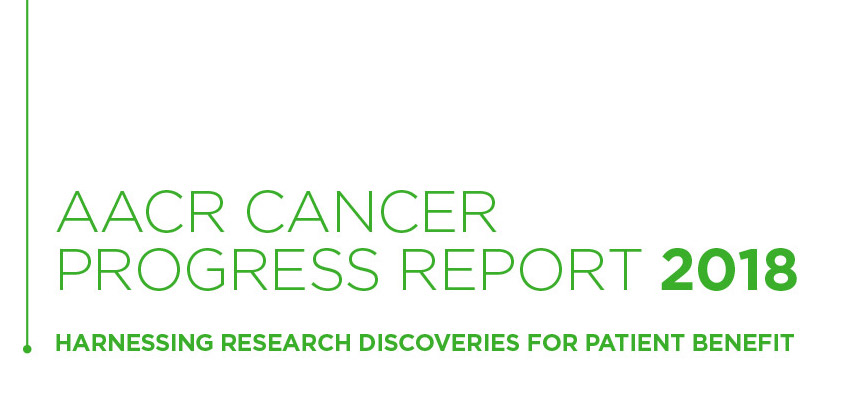Annual Cancer Progress Report Issued by the American Association for Cancer Research
The American Association for Cancer Research (AACR) has released its annual Cancer Progress Report, which describes how research improves survival and quality of life for people around the world because it spurs the development of new and better ways to prevent, detect, diagnose, treat, and cure cancer.
The key advances include:
- In the United States, the age-adjusted overall cancer death rate has been decreasing since the 1990s, with the decline by 26 percent from 1991 to 2015 that translates into almost 2.4 million cancer deaths avoided. In addition, the U.S. 5-year relative survival rate for all cancers combined rose from 49 percent in the mid-1970s to 69 percent in 2014.
- From Aug. 1, 2017, to July 31, 2018, the U.S. Food and Drug Administration (FDA) approved 14 new anticancer therapeutics. Among these treatments are novel immunotherapeutics called chimeric antigen receptor (CAR) T-cell therapies, targeted radiotherapeutics, and numerous molecularly targeted drugs that are expanding the scope of precision medicine. During this period, the uses of 11 previously approved anticancer therapeutics were expanded by the FDA to include additional types of cancer.
- The research that drives progress against cancer is made possible by investments from governments, philanthropic individuals and organizations, and the private sector.
However, many challenges still remain:
- Cancer accounted for 8.9 million or 16 percent of the 54.7 million deaths that occurred around the world in 2016, meaning that it accounted for one in every six deaths. In the United States, cancer accounts for a greater proportion of deaths than it does worldwide. In 2016, it accounted for 598,038 of the 2.7 million deaths, which is 22 percent of deaths.
- In the United States, it is predicted that the number of new cancer cases diagnosed each year will increase in the coming decades, rising from 1.7 million in 2018 to almost 2.4 million in 2035, largely due to expected growth of population aged 65 and older from 52.5 million in 2018 to 78 million in 2035.
- Also contributing to the projected increase in the number of U.S. cancer cases are continued use of cigarettes by 14 percent of U.S. adults and high rates of obesity and physical inactivity, which are both linked to some common types of cancer.
- HPV vaccination could prevent nearly all cases of cervical cancer, as well as many cases of oral and anal cancer, but less than 50% of U.S. adolescents aged 13 to 17 are up to date with the recommended vaccination series.
- The cost of cancer is enormous, both in the United States and globally. One study estimated that the direct costs related to the prevention and treatment of cancer, and the economic value of lives lost and disability caused, cost the world approximately $1.16 trillion in 2010. The costs of cancer care alone stand in stark contrast to the amount of money the federal government invests across all areas of biomedical research. In 2015, the same year that the direct medical costs of cancer care were $80.2 billion, the NIH budget was just $30.36 billion, of which $4.93 billion went to the NCI.
- Cancer health disparities pose another pressing challenge both globally and nationally. Only with new insights obtained through research and through the inclusion of all segments of the U.S. population in clinical trials will we develop and implement interventions that will eliminate cancer for all.
- Even though a poll of the general public showed that more than 30 per cent of U.S. adults would be very willing to participate in a cancer clinical trial if asked, fewer than 5 per cent of adults diagnosed with cancer participates in a cancer clinical trial.
Progress against cancer is driven by research discoveries. Future research highlights with the potential to fundamentally change cancer treatment in the future, include the following:
- Artificial intelligence has the potential to streamline processes for image interpretation from pathology slides as well as many other image sources that are routinely used in oncology, allowing for faster decision-making for people with life-threatening diseases.
- CRISPR-mediated gene editing for cancer therapy.
- Liquid biopsies have the potential to transform early detection, diagnosis, and treatment of cancer in the future.
- Examining the gut microbiome will augment our understanding of cancer development and may provide an exciting new avenue to improve cancer treatment.
Additionally, identifying ways to help survivors meet the many challenges they face after a cancer diagnosis is an important area of research investigation. Moreover, regulatory science initiatives at the FDA are vital to accelerating progress against cancer, as well as tobacco control policies will further improve public health and significantly reduce cancer risk.
Based on this report AACR announced its Call for Action to:
- Continue to support robust, sustained, and predictable growth of the NIH budget by providing an increase of at least $2 billion for NIH in FY 2019, for a total funding level of at least $39.1 billion.
- Ensure that the $711 million in funding designated through the 21st Century Cures Act for targeted initiatives, including the National Cancer Moonshot, is fully appropriated in FY 2019 and is supplemental to the healthy increase for the NIH’s base budget.
- Increase the FDA base budget in FY 2019 to $3.1 billion, a $308 million increase above its FY 2018 level, to ensure support for regulatory science and to accelerate the pace of development of medical products that are safe and effective. Specifically, the AACR supports a funding level of $20 million for the FDA Oncology Center of Excellence in FY 2019.
- Support the CDC Cancer Prevention and Control Programs with total funding of at least $517 million. This includes funding for comprehensive cancer control, cancer registries, and screening and awareness programs for specific cancers.
Source: https://www.

